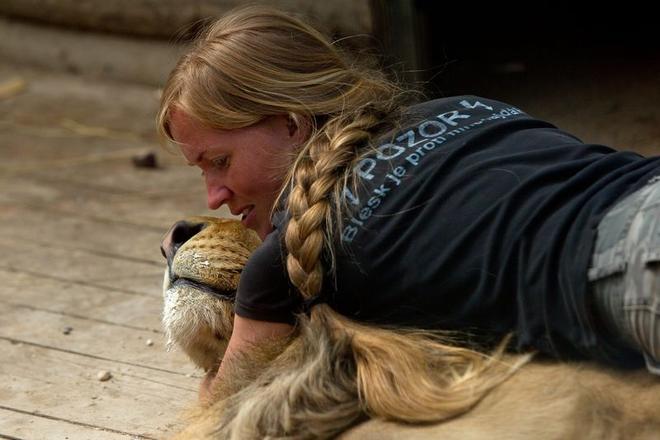IT HAS been estimated that 12 lions and 30 tigers are living in the vicinity of Trnava, the Sme daily wrote. In the village of Hrnčiarovce near Trnava a young man, Peter Ardan, enters an enclosure like a dog pen and calls out “Suri” and soon a young lioness greets him. The young man scratches the animal’s belly and later goes to a larger enclosure with seven other lions. This is not Africa but western Slovakia, about 50 kilometres from Bratislava, where Ardan breeds lions on rented land.
Ardan told Sme that he got his first lion, a male named Leo, from the Humberto circus when the circus had eight cubs at one time.
“I was asked to take care of him for two weeks and he has been with me for almost eight years,” Ardan explained.
Seven tiger cubs were born last year just 30 kilometres away in Kostolná pri Dunaji. Miška Kocmundová, their tender, knows them all by name even though they look the same.
“She can caress them all and even can lie on a young lion from the neighbouring enclosure as she has been with tigers since she was small,” said Yveta Iršová, their breeder and owner, to Sme. She keeps 30 tigers and three lions in Kostolná and told Sme that “when Markíza [a tiger] was born, she slept with me until she was two”.
Michal Prášek from Zvončín pri Trnave also sleeps comfortably while raising lions, telling Sme that “everybody has some kind of hobby: some people prefer fast cars, some motorbikes, and I came to like lions”. Though not exactly a normal hobby, breeding tigers and lions is on the rise in Slovakia, with the three breeders telling Sme that there are about 20 across the country. They added that they are upset about irresponsible breeders and the media, who they said are harming their good reputation, noting that breeding of these wild cats was often mentioned in the media in the 1990s in connection with underworld figures.
But the general public and the media sometimes are irritated even now. Kristína Mangová from the organisation Sloboda zvierat (Animal Freedom) told Sme that owning a tiger or a lion is not automatically bad and it does not mean that all breeders are of poor character. But she said her organisation is critical of a lack of unified rules in Slovakia for breeding these big cats.
Sme wrote that from an administrative point of view it is as easy to breed tigers as it is to establish a company. Only notification to the Environment Ministry and approval from the regional veterinary office are required. Sme added that village or town officials often have no information about these kinds of animals living within their jurisdiction.
Sme wrote that a lion cub can be purchased for €2,000, a young tiger may cost about €3,000 and fully-grown animals are only slightly more expensive, adding that breeders can acquire cheap food from farmers who have cattle that are not suitable for the slaughterhouse.
Prášek was attacked by one of his lions in Zvončín but the breeder did not blame the animal.
“It was my fault as I underestimated and neglected a lot of things: the lioness was in rut and my clothes smelled of dogs,” Prášek explained, adding that “it cannot even be said that the lion attacked me – I would not have been able to leave if he really wanted to attack me. He just got too excited”.
After the attack Prášek continued to tend the lions and visited a doctor only several hours later. “It was just a scratch when you consider the power of a lion,” Prášek commented but noted that he is “more careful now and goes inside with a shovel”.
Iršová discounted the danger of the wild cats escaping from their enclosure, stating that her tigers would not even cross the next fence because they do not like strange environments, while adding that lions are more curious.
The species owned by private breeders in Slovakia are generally the common lion (Panthera leo), the Siberian tiger (Panthera tigris altaica) and the Barbary or Nubian lion (Panthera leo leo). Iršová started breeding Siberian tigers in the 1990s in the Petržalka area of Bratislava and later moved to a more rural area around Senec.
“This is my work, my dream come true,” she said, claiming that breeders are helping to maintain endangered species that do not live easily in the wild anymore.
Ján Šiška, a vet from the Regional Veterinary Administration in Trnava knows all the lions in his region by name.
“I am from a village and I consider farms with sheep and cows more appropriate for Slovakia than enclosures with such exotic animals. This is a modern trend that cannot be stopped but it is as natural as putting up a large capacity cattle ranch somewhere on the equator – it defies logic,” he stated. He added that breeding these animals might help some threatened species to survive and they might have a better life than travelling with a circus.



 A slightly bigger pet. (source: Sme, Vladimír Šimíček)
A slightly bigger pet. (source: Sme, Vladimír Šimíček)